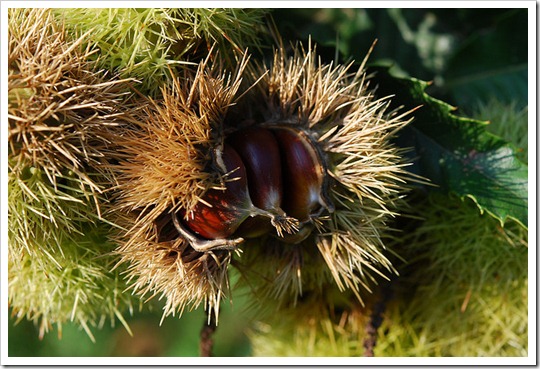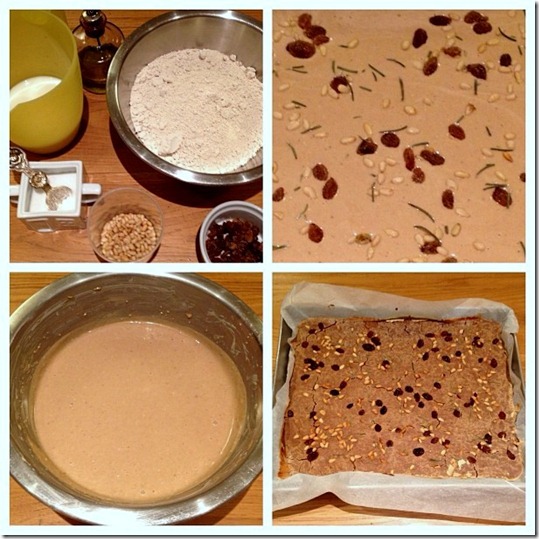Large parts of central and northern Italy are covered with castagneti (chestnut woods), and for centuries chestnuts were the main source of food for the contadini (peasants) during the winter. This is reflected in the large variety of chestnut dishes, both sweet and savoury, which are still popular today.
The traditional Tuscan pancake made from farina di castagne (sweet chestnut flour) is known by various different names. In the area between Lucca and Florence it’s called castagnaccio (literally: bad chestnut), near Siena torta di neccio, and here in Lunigiana pattona. Here’s the recipe for il castagnaccio, which is very simple. However, if you want it to turn out well, it’s important that the chestnut flour is of a good quality and naturally sweet.
| Ingredienti: |
Ingredients: |
| 300 gr di farina di castagne |
300 grams of sweet chestnut flour |
| 4,5 dl di acqua |
450 ml of water |
| 50 gr di pinoli |
50 grams of pine nuts |
| 50 gr di uvetta |
50 grams of raisins |
| 1 rametto di rosmarino |
1 sprig of rosemary |
| olio extravergine di oliva |
extra virgin olive oil |
| 1 pizzico di sale |
1 pinch of salt |
 |
| Castagne. Photo: (CC) by mauro |
 |
| Castagnaccio. Photo: (CC) Marco |
Preparation:
Soak the raisins in warm water for about 10 minutes, then drain them and pat them dry with kitchen paper.
Sieve the sweet chestnut flour into a wide mixing bowl. Slowly pour the water into the flour while mixing the batter with a fork or a whip to avoid lumps. When the batter is nice and smooth, add two tablespoons of extra virgin olive oil, a pinch of salt, and the soaked raisins. Carefully mix everything together.
Oil the bottom of a baking tray (about 24 cm wide) or line it with greaseproof paper. Pour the chestnut mixture into the prepared baking tray, and sprinkle the pine nuts and rosemary on top of it.
Put the baking tray in an oven preheated to 200°C (400°F), and bake for 30 minutes. The surface of the pancake should be all brown and cracked (see picture above).
Serve the castagnaccio warm. It’s particularly good with fresh ricotta cheese spread on it.
Variations: I like my castagnaccio the way I learned to make it from my next-door neighbour in Lucca. I sprinkle it with a little finely sliced orange rind, together with the pine nuts and rosemary. This adds a nice tangy taste that perfectly complements the natural sweetness of the chestnut flour.
Note: If the chestnut flour is not very sweet, add some caster sugar to the batter.
Folklore:
According to folkloric tradition, the rosemary used to flavour the castagnaccio is a very powerful elixir of love. If a girl offered a slice of castagnaccio to a young man, he would immediately fall in love and propose to her. Is it true? Well, tentar non nuoce (there’s no harm in trying).







Leave a comment: